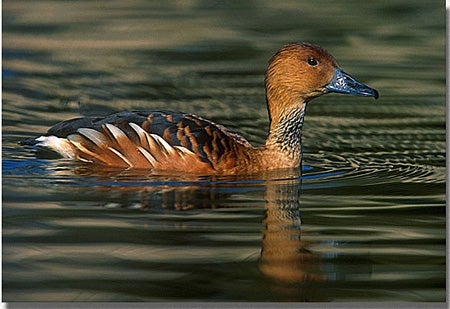SCIENTIFIC NAME:
Dendrocygna bicolor
OTHER NAMES:
Fulvous tree duck, Mexican squealer, squealer
STATUS:
Historical breeder. Occasional in spring, summer, and fall in Gulf Coast region. Occasional in late fall, winter, and early spring in other regions.
DESCRIPTION:
Looking more like a goose than duck, the males measure 17.7 to 18.5 inches with a weight of 1.1 to 1.9 lbs. Females measure 16.0 to 18.3 inches and a weight of 1.2 to 1.9 lbs. Both sexes have similar plumages, with the head, chest, breast and belly being a tawny-brown. The back is dark brown and the rump being white. The side and flank feathers have an ivory edge that forms a border between the sides and the back. A white V separates the brownish-black tail from the dark plumage of the back. The wings are brown-black with a russet brown patch on the shoulder. The bill, legs and feet are a blue-gray in color. During flight and feeding, they are very vocal.
DISTRIBUTION:
Fulvous whistling ducks are found worldwide from Burma, India to eastern Africa as well as South America, Mexico and California, Texas, Louisiana and Florida of North America. They will breed in southeast Texas and southwest Louisiana and migrate along the Gulf to Mexico. In Alabama, small numbers of fulvous whistling ducks may be observed along the Gulf coast.
HABITAT:
During the breeding season, fulvous whistling ducks prefer to nest in rice fields or in dense vegetation over or near water. During the winter months, they prefer to migrate from the rice field to coastal marshes along the Gulf.
FEEDING HABITS:
Fulvous whistling ducks feed by diving under water or swimming. They prefer to feed at night on rice; seeds of millet, nut grass and Paspalum grass. They will also feed in wet pastures containing knotgrass, signal grass and Walter’s miller as well as other aquatic vegetation.
LIFE HISTORY and ECOLOGY:
They begin to form breeding pairs in the spring and may keep the same mate for life. The females prefer to nest in rice fields, in Texas and Louisiana, that contain low contour levees or over water that contains rice plants and weeds growing between levees. In areas where rice fields do not occur, they will nest in dense vegetation of cutgrass, cattails and other water plants. The female will construct a nest over water made from surrounding vegetation. The nest is constructed as she lays her eggs and builds to the nest as more eggs are laid. The early laid eggs may fall through the flimsy prepared floor into the water before the nest construction is completed. The female will not add down feathers to line her nest. She will lay a clutch of 12 to 13 eggs that are incubated for 24 to 26 days. Both male and female will incubate and participate in brood rearing.
REFERENCES:
Bellrose, F.C. 1976. Ducks, geese and Swans of North America, 2nd ed. Stackpole, PA
Ducks Unlimited- www.ducks.org
Author:
Phil Miller, Wildlife Biologist, Division of Wildlife and Freshwater Fisheries






